A Guide to Custom Stockpiles
No idea what to produce for your stockpile, or how much of them? This is a common problem that even experienced logimen encounter. This guide will help you cut to the chase when it comes to prioritizing the supplies you need to achieve your goals. (Click to zoom)
The above chart shows which supplies are needed for each specific area of the game, covering all craftable items except combat vehicles. Your stockpile can look very different, combining different specializations. The numbers simply indicate an ideal ratio, and shouldn't be taken absolutely unless for a very large group. Get small amounts of supplies at the top first, then work your way down the chart. Once you have a little bit of everything, repeat the cycle until you have a satisfactory volume and ratio of supplies.
Basic Infantry Supplies
These are the supplies needed to sustain a standard frontline assault or defense. Altogether, expect them to empower randoms and organized groups alike and give them the necessary tools to push or hold in any circumstance, despite only costing scrap materials (bmats and emats).
Shirts and bmats are often the fastest to run out and as long as there is plenty of them a frontline providing the platform for serious infantry activity to make an impact. The two stabilizing components must always be readily available for a frontline to sustain itself in a given region.
The three excellent rifles available to the Wardens should equip the backbone of frontline infantry. Stocking up on 7.62mm weapons and ammo is ideal for starting out an infantry stockpile because a grand total of 4 types of rifles use the ammo type, and with bayonets, it performs 90% of what infantry weapons need to do. Loughcaster should always be available, and the Sampo and Blakerow should fill the needs for close quarters and night time combat when SMGs are not available.
Wardens are blessed with the Fiddler submachine gun, which boasts 25 rounds in clip excellent running and gunning capability. Fiddlers absolutely make a difference in infantry fights, expecially during nighttime, and can make or break a frontline. Keep many crates of both smgs and 9mm at a 2:3 ratio so that you can bring them to fronts where you are operating when they're not availabe.
Next after suitable antipersonnel weapons is PVE ability. Mammons are essential to press the advantage when your infantry have pushed and need to destroy structures. Having a bandage in the backpack will save lives almost half the time, so it is equally important.
Stickies are the most crippling cheap AT solution by far, even though they only come in 10 per crate and takes certain skill to use them. To complement these limitations, the White Ash AT Flask provides extra supply of throwables by coming in 15 per crate, and ATRs and 20mm are much more newb friendly in being able to be fired from a distance while sustaining reliable damage over time. When forced to choose, assume ATRs are good for big fronts where frendly infantry can fire massed volleys and stickies are good for smaller fronts where small groups or even individuals can sneak around use them to rush enemy tanks.
Medical supplies (that aren't bandages) should come after at least some AT weapons are in stock. Note that bandage count should always be higher than the rest of meds (First Aid Kits, Trauma Kits, Blood Plasma) because infantry likes to carry a bandage into battle. Medic uniform should not be omitted, since it encourages more people to actually play the medic role due to its benefits.
Filters usually run out faster than masks, so ratio is set accordingly. Chances are, most fronts have shovels, but reserve enough crates because a front without them is severely handicapped, since shovels not only bolster defenses, but also can be used offensively against enemy fortifications.
Antipersonnel grenades will provide effective crowd control, clearing trenches, and decrewing field guns. Frags are vital for pushing trenches. Green ash allows for spawn killing when friendly troops are in range of enemy base. Both storm rifles are decent, but the Aalto will always be more useful due to its full auto capability, compared to the Booker. It's main downside is less guns per crate, and slower movement. Since you get 10 storm rifles per crate and 30 7.92mm per crate, you can maintain a 1:3 ratio of guns and ammo with equal numbers of crates.
Binos are important for infantry squad leaders and AT teams to have so they can chart their course from a distance. Radios allow for catching enemy partisans that show up on watchtower intel as well as enemy tanks prowling at the flanks. During nighttime, it can replace the binos in giving you the intel you need. Wrenches allow for "borrowing" vehicles that is not being used at this particular moment. (Be sure to ask around if an rmat vehicle belongs to someone before taking it). Also, they allow for taking down all sorts of obstacles and mines, so every front should have at least 5. Snowsuits are only needed when it's wintertime, so just keep a few on hand for emergencies and make more when needed. The Clancy Cinder gets a lot of love, but it's a niche rifle that comes in 15 per crate. Loughcaster is faster to aim and still longer range than most colonial rifles, so only take the cinder when you really need that extra few meters to outrange enemy long rifles.
Smokes allow you to rush defenses or trenches by screening your approach. Radio backpacks provide map intel like a walking watchtower, which is useful when a no man's land is too heavily contested for friendly watchtowers. Mines can stop a large tank assault on its tracks, but they can also do the same for friendly armor. You can still see friendly mines from inside vehicles however, so experienced players will put them in bushes or spread them out randomly to allow friendly armor through but make it hard for enemies to keep track of where they are. The Outrider's mantle will allow its wearer to become invisible to enemy watchtowers, however with a chance of failure. It's better than nothing for friendly troops that want to try to flank around the enemy position to cut logi.
Tripods should be available even if you don't have things to put on them, because oftentimes our forces capture enemy ISGs or TMGs, and you want to use them against the enemy right away. And tripods are often in short supply even when there are a plethora of tripod mounted weapons available. A small amount of 30mm will not hurt to have lying around just in case this happens.
The .44 weapons like the Hangman are niche and not essential to the front, but some people are quite skilled with its one shot ability. Keep a few around when the other supplies are stocked up for the occasion. Cascadiers and revolvers are great for specialists, engineers, and medics. The Liar isn't a good weapon for firing on the move, which is what SMGs should excel at, but can be effective in a defensive role.
Vehicles
Plenty of logi trucks should be on hand to make quick deliveries, and at least a few tracked logi trucks on hand for transporting heavy infantry off-road, carrying extra materials and ordanance. The ambulance acts like a cheap LUV that provides personal mobility and protection to individual heavy weapons specialists, and the bus is a highly underrated vehicle that can turn disorganized infantry into a force of nature by channeling them in the right direction.
Advanced Infantry Supplies
Investing in a bit more expensive equipment and ordanance for the common foot soldiers can seriously turn them into a force of nature. These supplies cost rmats and HE mats, but they're worth every ounce, especially with good coordination from their users.
Grenade launchers are immensely useful rifle attachments that are cheap and come in large batches, hurling frags, gas, and HE projectiles at a great distance. Make sure these are available along with Tremolas, and the infantry's ability to push a frontline will be grealty enhanced.
Ratcatchers are tripod mounted heavy machine guns using 12.7mm, and allow infantry to destroy tier 1 structures from range and suppress the enemy at a very low cost of 5 rmats and some bmats per crate. It's the poor man's Malone HMG, which are mobile and do the job better in every way except being more expensive.
Foebreakers are the Warden counterpart to the ISG, and can become a powerful yet cheap early ranged PVE weapon. Again, the Cutler offers a mobile and vastly superior solution at a higher cost, without triggering AT retaliation. It's good against buildings and armor alike. The Foebreaker cannot be underestimated though, because with an organized team, its greater range, ability to burst two shots into unsuspecting enemy armor, and its greater difficulty in being lost to the enemy will outweigh its disadvantages.
The mounted bonesaw is a hard counter to any armored threat. Just a few of them placed strategically will wreck countless enemy tanks. By contrast, Bonesaw is a niche weapon that takes decent experience to not get killed in it before firing a shot, due to its short range. During nighttime, skilled users can use it to flank and seriously wreck unprotected enemy tanks however.
Mortar tubes, flare shells, shrapnel shells, and explosive mortar shells allow infantry to push during night and against heavily fortified positions. Massed mortars are super powerful, and if you can organize heavy infantry ops, this is always an option.
Alligator charges (Satchels) are insanely powerful late game, meltingall but the strongest of defenses like hot knife through butter. Though expensive, stockpile plenty for when friendly pushes are stalled by enemy concrete.
Clancy Raka sniper rifles are considered obsolete due to nerfs. Only keep these if you're looking to have fun.
Vehicles
LUVs will greatly assist seasoned heavy infantry by providing both protection and mobility as well as space. 100A LUVs provide map intel and are very quick with lots of inventory, so it pairs well with RPG gunners and satchel teams. Loscann ALUV can carry 4 people and passengers can use binos or fire their secondary weapons and thus serves as a mini APC.
Engineering Supplies
Building and maintaining defensive structures are crucial for the outcome of a campaign. Engineers would do well to prepare for possible hurdles well in advance in order for their projects to progress smoothly.
Large amounts of bmats will be needed for engineering projects. Keep supply 200+ crates for not only building but also repairing decayed structures and queuing gsups.
Bunker supplies will prevent bunker tiles and trenches from decaying, and serves as a backup for when garrison supplies run out in a base. Have both ready in copious amounts. Garrison supplies are most useful since they protect everything from concrete mixers to storage boxes from decay. For engineers, gsups are pure gold.
Binoculars allow engineers to correctly gauage AI ranges and make sure fortifications are placed correctly to respond to various enemy threats. Radios allow you to react to harassers or partisans ahead of time and wrenches make sure there is no vehicle you can't use. Shovels are the engineer's most prized tool.
A good starter kit should be on hand for when new bases are built and you need something to get it off the ground right off the bat. This includes a small amount of soldier supplies, mammons, bandages, and small arms. Fiddlers and 9mm is best since engineers can use the extra ammo to delete blueprints faster. Sledgehammers should be added to FOBs or bases nears scroop fields.
The biggest threat an undefended base can face is a group of base-hunting enemy tanks that show up and blow a base before defenders arrive. If skilled qrf personnel arrives in time, the tanks can be flanked and wrecked, but only if there are stickies available. (especially with binoculars) . Well placed mines will also prevent this from happening. Tripods should be available in case anyone wants to bring mounted ATRPG launchers or machine guns.
Vehicles
Logi trucks will help pull out bmats and maintain the stockpile. Tracked logi truck allows for taking bmats and supplies off-road and building in unconventionl spots.
Flatbeds will be needed to bring emplacements and haul in resource containers full of comps for concrete, while fuel trucks provide diesel to feed engine rooms to power observation bunkers as well as passing vehicles. Resource trucks will make quick trips for comps easier.
Packables
Concrete mixers are a must for advancing bunkers to stronger levels. Sometimes 1 isnt enough when you want to refine quicker or keep backups. They're individually reservable. Resource containers will help bring components in bulk.
Emplacement AT are the hard counter to any tank assault. Inside octogonal trenches, they gain lot of health and outrange most tanks, so make sure to surround your base with them. Emplacement MG mow down any incoming infantry but are useless against actual armor, so have them in between EATs. Best part about these emplacements is that they cannot be used by the enemy. The 120mm light arty is excellent when used defensively, and having at least one in any base will make a huge difference.
Barbed wire stops PVE infantry, expecially satchelers when placed ahead of defenses. Metal beams block tanks and also can be used to build field bridges. Sandbags provide good cover for friendly infantry and tripod weapons. Don't use them for backline bases since they will consume gsups. They are meant for frontline and urban uses, but frontline can always shift, so use them to soften up enemy impact when needed.
Armor Supplies,
Tanking requires a lot more than just vehicles and ammo. Make sure you have all the things you may possibly need to keep your operations oiled and primed.
The main item tankers need constantly is 40mm, as this is the ammo type most tanks use. 68mm is the next most sought item, used in vehicles that specialize in killing armor, as well as in field AT guns. Both are emat-heavy, so use the MPF as much as possible to save materials. Next, 7.92mm and 12.7mm are used in many armored vehicles and some tanks for the machine gun slot, and since they're cheap, make sure there's plenty of both in stock.
30mm is used for the King Gallant, and also captured colonial tankette as well as ISG mounted half-tracks. You never know if you will need it someday because you may capture or find a tank that uses it even if you never planned to. Same goes for the rest of the "niche" shells. 250mm is a super powerful PVE shell used by Chieftains, and hard to find on any frontline. 20mm is used by the Highwayman and captured Typhon TATRs that is excellent on a half track, being able to take on both infantry and armor alike. The ATRPG shell allows even cheap warden vehicles like the Gravekeeper and the bonesaw mounted half-track to deal crippling blows to enemy armor.
Often overlooked is how scarce bmats become when running tank operations. Silverhands should all have 100 bmats in the inventory, and tank crew needs up to 60 in their backpacks. This constantly needs replenishment as the operation progresses for repairs and armor restoration. Since there is no guarantee that there will be bmats when you need them, always keep an ample reserve. Gas masks and filters go without saying. Store more filters than masks, since each crew needs at least 3 equipped. Binoculars are a must for drivers and spotters to look ahead before approaching hostile territory.
Boiler Suit reduces encumbrance for bmats and allows for stacking of filters, and is highly recommended for tank crew. All personnel must also have radios because this is the best way to prepare for sneaky enemy sticky rushers or locating enemy armor positions. Each vehicle should have at least one person with a wrench, to disable mines or unlock enemy/friendly vehicles upon need. Finally, a bandage in everyone's backpack should not be forgotten since there will be no medics to patch you up if you ever bleed.
Cooler pistols are optional, and can be helpful. Spotters can use the cascadier to spray burst shots at enemy sticky rushers or pack a more powerful punch with the revolver. Even still, the default handgun is pretty decent having good range and ammo capacity. The spotter may want to use the caovish parka when there is a snowstorm, because you will freeze if you sit with the hatch open for too long.
Not exactly essential but good to have are the SMG and 9mm for crew members that want more stopping power against enemy infantry during emergencies, such as when tank is disabled. There is also no harm in everyone carrying a green ash, since it's very lightweight and when you manage to disable enemy tanks you don't have to waste time trying to find it elsewhere.
Instead, some might opt to carry a sticky bomb or white ash instead, to either finish off their own disabled tank lest it get captured, or throw it at the enemy when you have no other options. This can certainly surprise the enemy and make a difference. RPG shells aren't used by any warden vehicles except the Foebreaker mounted half track, but plenty of colonial vehicles do.
Vehicles
The logi truck will provide bmats and munitions for tank operations unpon need. The tracked logi truck can escort tanks off road and supply extra bmats and fuel. But for a normal tank operation you will want to bring your own fuel truck.
100A LUV is an excellent mechanic vehicle that stores fuel and bmats for tanks on the move, and also gives map intel thanks to its radar ability. The Loscann ALUV can do a similar task but is slower, has less space, while being able to carry 2 more people. This can be a form of mechanized infantry that supports a tank group with repairs and counter infantry. Flatbeds will be useful for bringing tanks to a staging depot or seaport, and clearning out the mass production factory of vehicle crates.
The Ironship freighter can make an expedition far from the logi hub much simpler. Simply load it with a mix of assorted armor, LUV, and truck crates, a loaded fuel truck, shipping container full of shells, bmats, crew supplies, some starter kits, and anything else you might need. Then drive it to the closest seaport to the frontline you want to assault, and create a new stockpile there for the supplies. Presto, you have an entire invasion operation ready to go in a single shipping run.
Artillery Supplies
An artillery operation is 80% logistics. As long as you have a good spotter, the outcome of arty ops will depend on the sheer amount of shells you can bring to bear. In addition, don't forget the essential basic items that makes saves time searching for them.
Expect at least 100 crates of 120mm to be used for any decent operation. Stock up hundreds for truly impactful barrages. They are great for seiging fortifications, pressuring enemy armor, and wiping out infantry swarms, both offensively and defensively. Plus, it can be used in gunboats when you want to snipe enemy bunker cores close to the shore. 150mm costs HEmats, but are worth it as it devastates buildings and cripples armor. Having several hundreds of crates will wipe out all but the strongest of defenses. Flare shells, shrapnel shells, and mortar shells are good to have in reserve, for supplying smaller indirect fire operations using mortars, mortar tanks, or mortar houses.
A large amount of bmats are essential to begin and sustain an artillery operation. They are needed to set up the FOB and tier 2 trenches to emplace the guns, and also to out-repair the enemy when it comes down to an artillery duel. Binoculars will be used by spotters, while shovels are needed to create arty pits. Radios will help you figure out enemy targets even during night time. Cremari mortars will light up the night with flares, and also prove devastating against buildings when fielded in large groups.
Gas masks and filters can save the lives of arty crew and repairers against gas, which can easily happen during arty duels, where your AI activated defenses go down, everyone focuses on repairing the main core, and sneaky enemies chuck gas grenades at the huddled friendlies. Wrenches will save you from headaches when you need to commandeer trucks to help pull out arty shells.
Vehicles
Flatbeds will carry the arty guns and containers full of ammo to the frontline. Logi trucks will pull out the shells from containers and also assemble them from the FOB quicker. For off-road setups, the tracked logi truck will prove more useful.
Packables
The 150mm cannon is to be made sparingly unless you can make a large amount of shells for it. 120mm cannon can be made liberally because it's cheap, and its ammo is plentiful.
Large containers will transport 60 crates of shells and other supplies to a depot nearby to a front, so that logi trucks can easily pull from them to the target destination. Small containers will transport 40 crates directly to a frontline base, but it will take some time to pull them out. Make both types so you can decide the best way to deliver your ammo depending on the situation.
Partisan Supplies
A single player can deal a crippling blow to the enemy with nothing but a wrench and creative thinking. The key to excelling as a partisan is to increase your options to cause mischief as much as possible. Partisans won't be carrying much, but as long as they have the right tools they will punch above their weight and contribute greatly to the outcome of the war.
Binoculars will allow partisans locate juicy targets and avoid danger from a greater distance, especially for passengers of motorcycles and some LUVs. Radios will be useful when they bring intel gathering vehicles of plan to use intel from watchtowers and listening kits. Wrenches are a must for any partisan team, primarily used for stealing enemy vehicles. Shovels can be used to make trenches and foxholes that keep partisans warm and protected for ambushing enemy logi trucks. Bmats will go into building watchtowers, pillboxes, fire pits, storage boxes, etc in the enemy territory to give friendlies an edge against enemy QRF.
Fiddler smg and 9mm is the best primary weapon for a standard partisan ranger. It's able to spray bullets and disable passing logi trucks as well as crippling enemy QRF infantry and LUVs while staying lightfooted and on the move. Having a bandage is a must for any combatant, and the cascadier goes well with vehicles with a passenger seat that you can shoot out of, such as mortorcyles. Mammons are a cheap and low tech counter to enemy watchtowers, and recommended for partisan teams without other PVE equipment.
Here comes the good gear. Malone HMG and 12.7mm is where you can start dealing serious damage. The HMG will kill tier 1 structures like watchtowers and rifle pillboxes/garrisons, encampments, and tier 1 bunker bases. This leaves a gaping hole in the enemy anti-partisan network, that paves way for other partisans to make greater impact. Cutler launcher and RPG shells bring this to the next level, as you can kill tier 2 structures as well as incoming armored QRF. The only downside is limited shells you can carry, but this can be overcome by using specialist uniforms, in addition to LUVs or ambulances.
Satchels are the answer to erasing concrete the map. It will blow up pretty much anything, from town halls, concrete bases, storm cannons, intel centers, etc. Keep plenty of satchels flowing for serious partisan operations. Listening kits and tripods help out allies tremendously, stealing intel from enemy watchtowers and observation bunkers.
Vehicles
Tracked Logi trucks are severely underrated as a partisan vehicle. It can transport 6 people with plenty of bmats and ordanace off road and through winter, to enemy logi routes where you can build pillboxes and ambush logi. Regular logi trucks will help with backline work and preparation. Ambulances can be treated as a cheap personal ox-cart for heavy partisans carrying RPGs and extra shells. Mortorcycles are great for Malone gunners and passengers with binos and pisol to terrorize enemy backlines at high speeds, destroying watchtowers and chasing logi trucks.
If rmats can be spared, always invest in the 100A LUV, since it does the job of an ambulance but better (faster, harder to disable, etc). The Loscann ALUV will bring partisans across rivers and allow you to shoot pistols from inside like a motorcycle, but its fuel efficiency is terrible so most of the inventory will go towards extra diesel. Aquatipper barges can be made easily at shipyards but it may be useful to keep some in reserve for quick pirate operations, where you gas enemy freighters and capture them. Barges can also carry heavy partisans and accompanying vehicles to areas accessible only by sea.
Public Logi Supplies
Sometimes you just want to help the frontline as much as possible. For the chad logi mains out there, here is a model you can stick to that maximizes public benefit using mostly common resources. Public logi has a heavy infantry focus, while also thinking of random engineering, armor, partisan, and artillery personnel.
Bmats and shirts are the bread and butter of logi. They have an insanely high burn rate for active fronts, and theoretically a front can defend with pure bmats and shirts in the face of all but the heaviest attacks. Gsups and bsups are very good to keep producing on a constant basis when slots are empty. Gsups are precious and no factory should be idling gsup queues. If busy, don't worry about it.
Loughcaster rifles and 7.62mm ammo are bare essentials. You don't actually need 80 crates of 7.62mm right away, but if you went down the rest of the list and got all the different types of rifles that use 7.62mm, this is how the ratios will work out to. Bandages go fast, and should be always available. Mammons are the most reliable PVE weapon for massed randoms, and so keep plenty of them.
Shovels and bayonets will pretty much complete the most basic needs of a frontline, giving bunker and trench-supported defensive capabilities and ability to charge enemy trenches. Gas masks and filters will prevent total massacres of entrenched allies or spawn camping.
AT Sticky Bombs and Neville AT Rifles/20mm will reliably counter enemy tanks while being cheap enough to be delivered liberally. Both are always needed. ATRs offer area denial while stickies allow for surprise killing of enemy armor. Gas and frag grenades are necessary for clearing trenches and stopping mammon rushes. They also run out quickly so make lots.
First aid kits, trauma kits, blood plasma, and medic uniform will extend the frontline's supply situation by preventing deaths. As public logi you will notice most fronts already have medical supplies but lack the essential grenades and AT weapons. This is why the meds are put on a lower priority level for production. 12.7mm is always important to have, even without the guns to fire them, since other logi will bring EMGs to fronts that have the 12.7mm.
Once the frontline basics are taken care of, you can spice things up with different types of weapons. Fiddler and 9mm should accompany the rifles for night fighters and "can't aimers". The Sampo, Blakerow, and Clancy Cinder will keep infantry work interesting while makomg efficiemt use of the unified ammo type.
Binoculars, radios, wrenches, tripods are utilities that truly complete the frontline experience. Without them, great frustrations can ensue. Although not needed by everyone, they only come in 5 per box, so they tend to run out quickly. Keep ample amounts in stock. Sledgehammers don't run out often but sometimes you just need them for newly built FOBs at scrap fields, or a frontline BB near captured components.
Aalto storm rifles are a great boon to the infantry assault capabilities while 7.92mm is used by random armored vehicles as well as the small arms. RPG shell, 30mm, and ATRPG shells should be availalbe in reserve in case a frontline has the weapons to use them but not the ammo, which happens frequently.
Tremolas are cheap and can be launched safely using GLs, so keep ample amounts ready for the occasion. Flare shells, shrapnel shell, explosive mortar shells come in handy for beseiged towns that have mortar houses, and for frontlines with mortars and mortar tanks. AT mines can make a huge difference if used right. Keep plenty available to bring to bases in danger of being rushed by tanks.
Listening kits and radio backpacks aren't deal breakers, but you never know! There is a chance that friendlies will use them to great effect. 120mm shells can be stocked up to arm bases with abandoned cannons or sustain arty ops that run out of ammo. AT Flask can bolster the presence of AT sticky bombs when there isn't much room in the truck. The specialist uniform should always be delivered to places that have rpg launchers. RPGs are expensive, and there is no excuse not to also have a cheap uniform to make them more useful.
Smoke grenades will give some vets a chance to cheese enemy defenses. Don't count on it though. 68mm is like the tank version of the 12.7mm. An EAT can be delivered if a base already has 68mm. 40mm is constantly demanded by random tankers as soon as tanks are unlocked. Though 40mm is pricy, if you indeed see there are many friendly tanks operating somewhere, be generous and help them out and boiler suits are also a small way to show tanker appreciation.
Revolvers, hangman, and .44 are non essential but very fun to use. Why not keep some around when you got everything else down? Liar SMG is inferior to the fiddler and the same logic applies. Caovish parka does keep the cold at bay, but when winter strike they are plentiful and plenty of fronts get by without them. Worry about it when everything else is taken care of.
Foebreaker, Ratcatcher, mounted Bonesaw, and rifle grenade launcher cost very small amounts of rmats and are totally worth it to supply the randoms with. If you rather not compete for any rmats, pure bmat/emat weapons are fine too, as they do the job 90% of the time. Outrider's mantle is niche for randoms yet cheap and can be useful.
Cutlers, mortar tubes, and malone HMG allows infantry to do serious work. However they're expensive and randoms can easily lose them to the enemy which can be less than ideal. Only supply them to fronts that are pushing heavily or safe. Sapper's uniform is considered rather redundant when the boiler's suit exists. Not the worst thing to have on the battlefield however.
250mm is required by such few instances that normally you never have to deliver them. When a frontline does have field mortars or chieftains active, they will greatly appreciates even a few extra crates. Same applies to 150mm, though most 150mm arty ops will have plenty of their own, and rarely expect it from public logi. Alligator charges (satchels) however, are like cutlers and a frontline will do insane amount of damage when they're available. If you got the HEmats, go all for it.
Bonesaw requires high skill to use effectively, and most newbs will lose it without firing a shot. It will devastate tanks at night however. Clancy Raka is very bad after the latest sniper nerf. They can be an annoyance to the enemy. The gunner's breastplace is adored despite its limitations. It won't turn the tide of battle but nothing raises morale like a few shiny knights in the trenches of hell.
Vehicles
Logi trucks should be mass produced often, since they get lost easily, due to people being too lazy to bring it back, especially for long distances. Flatbeds will carry containers and vehicle crates as well as emplacements. Make enough to last. Oilbaronning can become your job, and fuel trucks are essential to keep nearby mines running as well as save frontlines from winter, or keep tanks fueled.
Ironship freighters are going to be your most efficient method of bulk transport. They only cost bmats, carry 300 supply crates at a time, and don't need to be driven back home, since they're expendable. Either mass produce (need to use shipping container full of public bmats), or build by hand. There is controversy over which is better for the faction. The tracked logi truck can go offroad and also replace the logi truck in a pinch. The leatherback is not as useful as you would think, but when running through partisans, it's better than the regular kind. Though if you really want to run blockades, you should use the 100a LUV. They're faster and more bullet resistant. A small number of reservable harvesters shold be available on standby in case a scrap field doesn't have any.
Resource trucks are redundant once you get a flatbed, but they're not bad for pulling from mines. Ambulances are basically a poor man's LUV. Both will grab supplies from the MPF efficiently because 9 slots is the max queue for regular supply crates. Pro tip: keep some cranes reserved in a seaport. When freighter traffic gets heavy, people can fight over the fixed seaport cranes and it can get ugly. Park regular cranes next to the seaport and the problem is solved.
Packables
Large Shipping containers will go quickly when you have an active freighter network. Make plenty. Resource containers are usually going to stay stable since they get reused, but sometimes a player made port (i.e. port tobasco) will need lots to get started. Some people like to use small shipping containers, but it takes so long to pull things out of them that it will usually be better to use a stockpile at nearest depot or seaport, then transfer the supplies to a logi truck.
EATs and EMGs only cost bmats and can be spammed without worry, since enemies cannot capture them. MPF and ship to front using bulk transport.
Pallets can be a hassle to bring to front but are very useful for both offense and defense. Have each type in reserve. Sandbags for fronts that are trying to push under heavy fire, metal beams for bridge battles (tank traps make good cover, and field bridges help a lot), and barbed wire for bases that are trying to defend with low pop.
War 87 1AC coalition Stockpiles Snapshot
Finally, we covered everything! It sure is a lot to think about. A good reserve stockpile not only prepares for every situation in the right amounts, but also serves as a collaborative platform for large numbers of people to work together at their own pace. Think about what your fellow comrades may need, and you can make a huge difference in helping build a community that has loads of fun together.
-Mountedantman
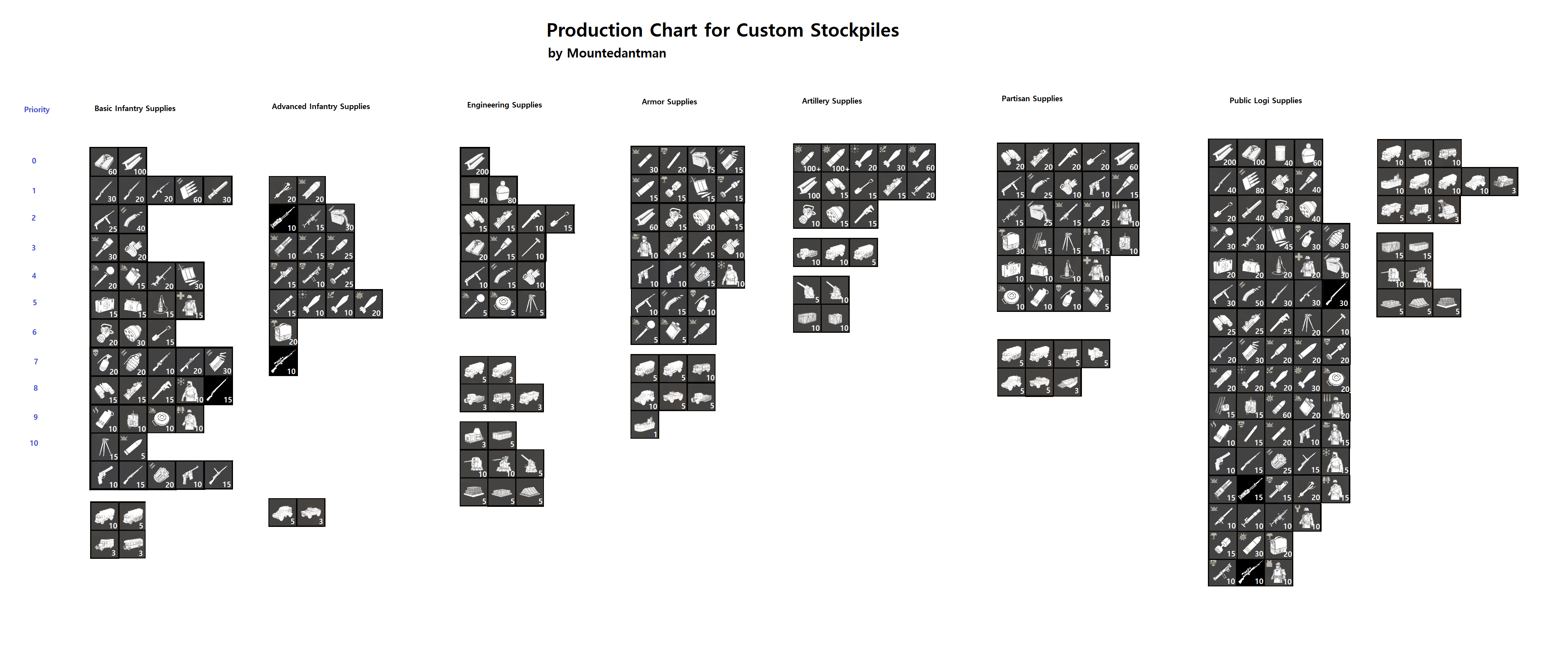








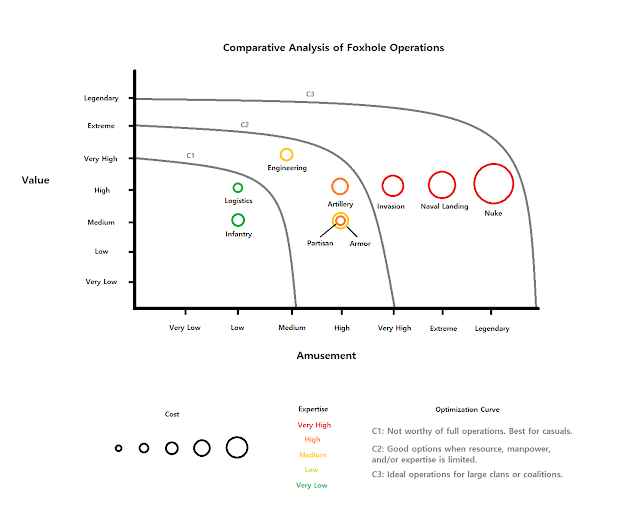


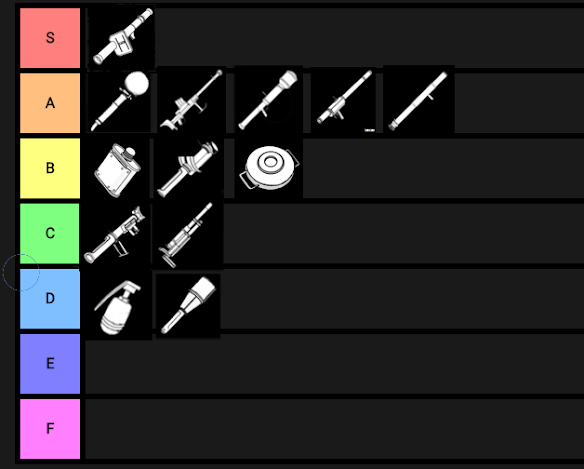
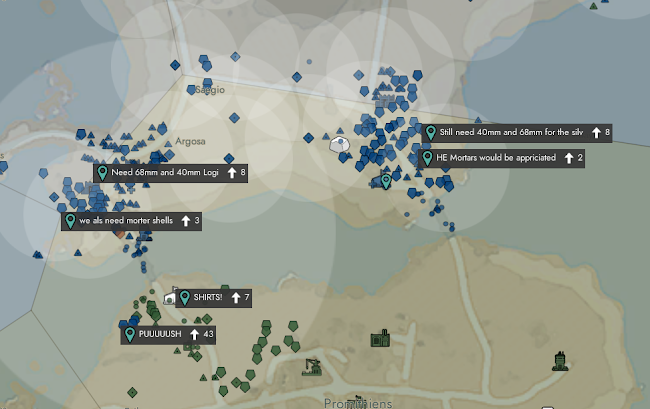

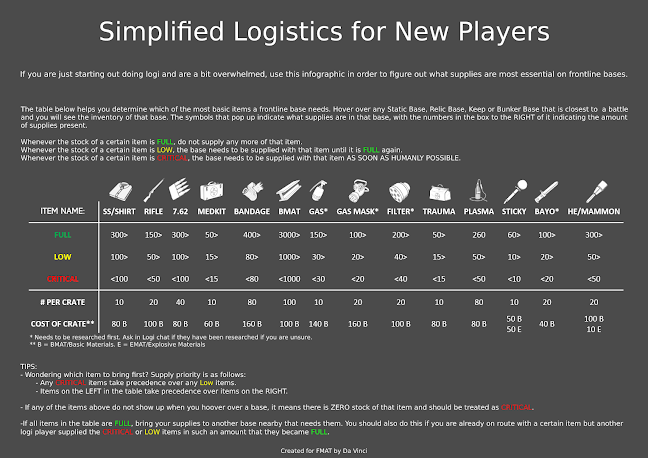
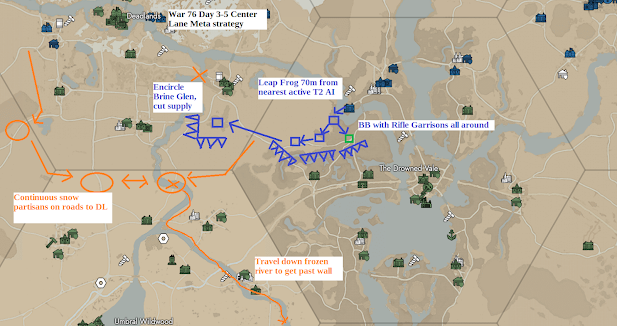
Comments
Post a Comment
Share your thoughts!